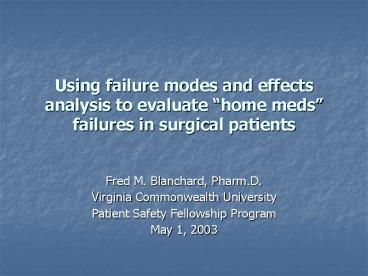Using failure modes and effects analysis to evaluate PowerPoint PPT Presentation
1 / 23
Title: Using failure modes and effects analysis to evaluate
1
Using failure modes and effects analysis to
evaluate home meds failures in surgical patients
- Fred M. Blanchard, Pharm.D.
- Virginia Commonwealth University
- Patient Safety Fellowship Program
- May 1, 2003
2
Purpose
- Introduce FMEA methodology
- Incorporate FMEA into Performance Improvement and
Patient Safety Efforts - Apply FMEA and evaluate home meds failures
3
Methods
- Establish a team
- FOCUS PDSA
- FMEA Training
- FMEA
- Define, Prioritize, Measure Failures
- Intervene
- Re-measure
4
Home Meds Team
- Dale Bosiger, Pre-op Education
- Debra Coulter, PACU
- Lynn Harris, Surgicare
- Nadine Gilmore, Pharmacy
- Linda Lange, Nursing Policy and Procedure
- Sherry Payne, Orthopedic Unit
- Randall Puckett, Pharmacy
- Kim Woodley, Quality Support Services (PI)
- Fred Blanchard, Pharmacy
5
FMEA
- Originally intended for prospective
identification of failures - Applied retrospectively as a stand alone process
in the healthcare environment - Also applied as a tool in FOCUS PDSA
6
PI and FMEA Similarities
- FOCUS PDSA
- Find a Challenge
- Organize a Team
- Clarify Process
- Understand the Variation Select a Process
- P-D-S-A
- FMEA
- Define Topic
- Assemble Team
- Describe Process
- Hazard Analysis
- Action/Outcome Measures
7
Graphic Description of Process
8
Subsystem Steps and Causes
9
Failure Mode
- 2g1 Nurse transcription from patient form to
assessment sheet is illegible
10
Failure Analysis
11
Potential Cause
- 2g1(e) Form not suitable for writing complete
medication instructions including drug, strength,
route, and frequency
12
Hazard Analysis 2g1(e)
- Severity Major
- Probability Frequent
- Hazard Score 12
13
Decision Tree 2g1(e)
14
Action Type
- Control
- Accept
- Eliminate
15
Action and Outcome Measures
- Measure error rates at baseline
- Develop a new form combine steps
- Perform a trial
- Measure post intervention error rates
16
P R E O P N U R S E A D M I T R E C O R D
O L D F O R M
17
Baseline Measure of Current Process
- Retrospectively reviewed 94 charts-all same day
surgeries over a three week period
18
Baseline Measurements
Before
Charts with Home Meds documented pre-op 94
Charts with any order to renew Home Meds post-op 69
Post-op Home Meds order qualified 84
Post-op Home Meds orders complete 34
Post-op orders that were clarified 44
Average number of Home-Meds pre-op 5.7
Average number of Home Meds renewed post-op 2.7
Drug, Strength, Frequency, Route info pre-op 91
Drug, Strength, Frequency, Route info post-op 98
Discrepancies post-op 22
19
R E S U M E H O M E M E D S F O R M
N E W F O R M
20
Post Intervention Utilization of Combined Home
Meds Form
- Retrospectively reviewed 51 charts-all same day
surgeries over a two week period - New form used by nursing staff 45 times (88)
- New form used by nursing and physician staff 35
times (78)
21
Results
Before After
Charts with Home Meds documented pre-op 94 100
Charts with any order to renew Home Meds post-op 69 100
Post-op Home Meds order qualified 84 100
Post-op Home Meds orders complete 34 100
Post-op orders that were clarified 44 0
Average number of Home-Meds pre-op 5.7 6.3
Average number of Home Meds renewed post-op 2.7 4.9
Drug, Strength. Frequency, Route info pre-op 91 99
Drug, Strength, Frequency, Route info post-op 98 99
Discrepancies post-op 22 0
22
Discussion
- Advantages of using FMEA in the context of FOCUS
PDSA - Identification of failures
- Greater depth of analysis
- Improved prioritization of selected processes
- Limitations
- Time consuming
- Reserve for critical processes
23
Discussion
- Home Meds Reorder Process
- Combining pre-op medication history with post-op
order set - Reduced process variation
- Improved pre-op documentation
- Increased frequency of post-op renewal
- Improved the completeness of post-op orders
- Reduced calls to clarify orders
- Increased probability that meds taken at home
were continued post-op - Reduced the number of post-op order discrepancies

